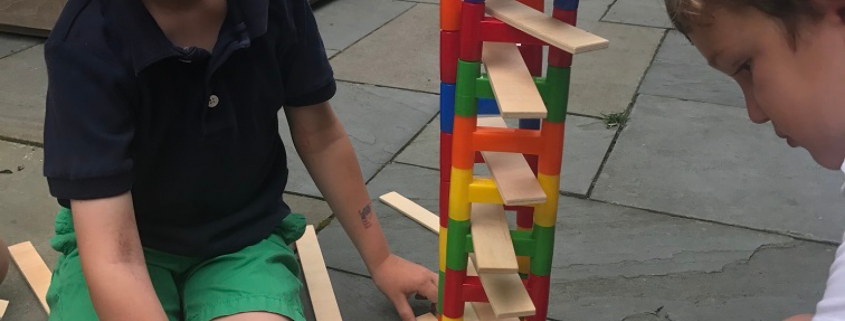Constructive Play is the Secret to Cultivating a Creative Mind at Any Age
Parents are inundated with advertisements for hundreds, if not thousands, of toys claiming to make their children “smarter” or more interested in math and science careers. Yet, the vast majority of these assertions are empty promises, backed by no evidence whatsoever. Today’s children spend an enormous amount of time in front of TVs, computers, and video games – with unknown long-term effects. Early evaluations suggest diminished ability to process information, recall, and concentrate.
Building blocks are a timeless classic, with stones and rocks likely a child’s earliest playthings. In 1693, English Philosopher John Locke referenced alphabet blocks as a way to make learning to read a more enjoyable experience. Numerous scientific studies make the case for block play as a brain-building activity. From mathematics and science, to fine motor skills and literacy, blocks set the foundation for learning. Though oft-overlooked for its simplicity, the building block is a gold mine for skill building in our midst.
How Does Block Play Affect the Developing Mind?
Decades of research show that children who play with blocks:
- Excel in math over a decade later, and show a particular interest in STEM careers.
- Are better at counting, adding, subtracting, and using spatial language like “above” or “below.”
- Developed better spatial intelligence, 3-D modeling, and visualization.
- Perform better at divergent problems after playing with chunky foam blocks than with puzzles.
- Form stronger social relationships and high-quality friendships by cooperating with others.
- Score higher on tests of vocabulary, verbal comprehension, and grammar as toddlers.
- Display improved competence in math, spatial reasoning, and executive control in 1st
- Have bigger 1st grade vocabularies, particularly after playing with town and community blocks.
- Are 31-38% better at performing complex mathematical word problems in 6th
- Develop strong spatial language and reasoning by speaking and collaborating with others.
- Score above average in language assessments, despite low-income environments.
- Show marked brain scan activation in regions associated with motor and spatial processing.
Beyond scientific measurements of achievement, children engaged in block play are flexing their creative muscles, as they dream, build, and express themselves. They gain confidence as they stack the tower higher and overcome small adversities. Children first discover that they can bring their unique ideas to life. They explore the notions of object continuity and permanence. As they work in a group setting, they are studying the work of others, cooperating, taking turns, sharing materials, asserting themselves, and boosting their attention spans.
Stages of Block Play
The National Association for the Education of Young Children notes eight different stages of block building that children advance through:
- Discovering blocks – exploring the physical properties of carrying, dropping, and packing.
- Stacking blocks – using repetition to create basic structures.
- Complex stacking – incorporating dramatic play as rows become train tracks or highways.
- Making enclosures – engaging in more pretend play to imagine animal pens and houses.
- Creating bridges or arches – exploring trial and error by connecting blocks together.
- Combining enclosures and bridges – advancing to more daring and complex combinations.
- Building with patterns and symmetry – sorting, seeking equivalency, and tending to details.
- Building block structures that represent pretend playobjects – roleplaying and planning.
Make Your Block Play More Constructive
There’s always room for involved parents to join the fun. Experts recommend:
- Making time each day for blocks at home.
- Supporting the child’s decision making with positive statements.
- Prompting (ex: “Let’s build a castle”), but following the child’s lead.
- Talking about shapes, sizes, colors, and number of blocks while playing.
- Using spatial words like “beside,” “beneath,” “over,” “under,” and “above” to narrate.
- Asking open-ended questions about the building process (like “Do you think it’ll balance?”)
- Adding in character toys, cars, zoo animals, or other structures to encourage pretend play.
- Cutting animal pictures in half and taping them to Mega Blocks to encourage matching.
- Saving household materials like boxes, cans, and Popsicle sticks for creative building.
- Occasionally changing the scenery, taking blocks to the garden, sandbox, or the park.
- Experimenting with Edo Blocks, Jumbo Blocks, or Giant Waffle Blocks (preschool & up).
- Using pictures, diagrams, or games to encourage specific construction projects (for older kids).
- Combining block play with story time, illustrating parts of the story with blocks and accessories.
Join the Shine Block Party!
Block Party, one of our signature classes and workshops, is the perfect introduction to the constructive arts for the Legos-Lover. Aspiring architects experiment with different building materials, from sugar cubes and marshmallows, to tree blocks and sculpting materials. We also offer custom classes of up to 12 sessions for advanced builders. Parents and kids alike love our hands-on approach that feels like free-spirited fun, but also lays the foundation for math, science, and artistic talents for years to come.
RESOURCES:
- https://www.parentingscience.com/toy-blocks.html
- https://www.parentingscience.com/Lego-bricks-construction-toys-and-STEM-skills.html
- https://www.naeyc.org/resources/pubs/yc/mar2015/ten-things-children-learn-block-play
- http://www.sheknows.com/parenting/articles/844895/lessons-to-teach-while-playing-with-blocks
- https://littlebinsforlittlehands.com/kids-build-lego-creations/
- http://www.huffingtonpost.co.uk/entry/the-joy-of-building-blocks-for-very-small-children_uk_599565a5e4b0acc593e55588
- https://handsonaswegrow.com/lots-of-blocks-activities/
- https://teaching2and3yearolds.com/fun-block-activities-for-toddlers-and-preschoolers/
- https://playedo.com/en/
- https://www.sciencedaily.com/releases/2013/09/130924091804.htm
- https://www.npr.org/sections/ed/2015/02/12/385264747/q-a-blocks-play-screen-time-and-the-infant-mind
- http://bayareadiscoverymuseum.org/blog/block-play-math-skills/
By Jenn Fusion for Shine
|



